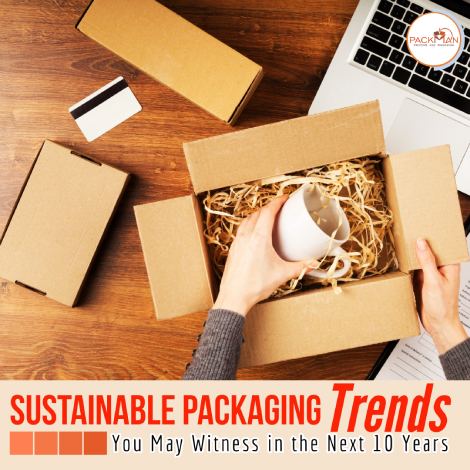From ancient vessels to modern-day cardboard boxes and PET bottles, the packaging industry is in a perpetual state of evolution. In the current era, as environmental concerns take centre stage globally, sustainability isn’t merely a buzzword—it’s an imperative.
In this blog, Packman Packaging, India’s leading packaging supplier and manufacturer of corrugated boxes discusses the emerging sustainable packaging trends that are poised to shape the industry over the next 10 years, driven by the ever-growing emphasis on eco-conscious consumerism.
What would the trends to witness for sustainable packaging in the next 10 years be?
Mr. Gaurav Jalan, Founder of Packman Packaging says the world of sustainable packaging is changing rapidly and this will lead to the following trends:
1. Biodegradable Materials
Plastic, widely used for packaging since the 20th century, poses environmental issues due to its slow decomposition. To address this, biodegradable options like starch, cellulose, PLA, PHB, and plant-based materials from sugarcane, coconut, hemp, and cornstarch are gaining popularity. These eco-friendly alternatives are cost-effective for businesses, with smaller carbon footprints. As consumer awareness grows, the demand for biodegradable packaging is set to rise, driven by innovations in plant-based biomaterials, offering sustainable solutions and reducing environmental impact. Innovations in biomaterials, such as bioplastics derived from plant sources have a smaller carbon footprint than traditional plastics and are hence ideal for sustainable packaging.
2. Reusable Packaging
The throwaway culture is making way for a new paradigm—reusability. In the next ten years, we anticipate a surge in reusable packaging solutions. From refill stations for household products to durable and stylish reusable shopping bags, the focus will shift from single-use convenience to long-term functionality.
Brands will likely invest in designs that encourage consumers to actively participate in reducing their environmental footprint by opting for reusable packaging. The “zero waste” concept will gain traction, promoting widespread adoption of durable, returnable, and sanitizable packaging systems, requiring collaborative efforts between brands and consumers for success.
3. Sustainable Inks
In 2023, the packaging industry is witnessing a notable shift towards environmentally friendly inks, responding to increased demand from organizations aiming for greater sustainability in their branding efforts. Sustainability in packaging extends beyond materials, encompassing inks and labeling. Plant-based alternatives, such as soya-based and vegetable inks derived from renewable sources, are gaining prominence over petroleum-based counterparts. Eco-friendly labeling materials that are easily recyclable or compostable are becoming standard, reflecting a holistic approach to sustainable packaging.
4. Smart Packaging
Innovative smart packaging solutions are revolutionizing the consumer experience. QR codes and RFID tags provide detailed product information, supply chain transparency, and reduce over-packaging. Enhancing sustainability, these technologies empower consumers with informed choices and enable brands to track products efficiently. QR codes, serving mobile-first audiences, offer tutorials and information, fostering improved consumer interaction. Anticipated growth in interactive packaging in 2023 aligns with sustainability goals, minimizing excess materials and enhancing user engagement.
5. Minimalistic Approach
Packaging design is shifting towards minimalism for both aesthetic appeal and sustainability. Emphasizing simplicity reduces the use of materials and energy during production. Brands prioritize conveying messages through streamlined designs, using eco-friendly inks and materials for a subtle yet powerful impact. Sustainability is achieved through optimized dimensions, lightweight materials, and minimized waste, resulting in lower environmental impact and cost savings across production, transportation, and waste management.
6. Recyclability
The next decade is set to witness a paradigm shift towards a circular economy, where packaging materials are designed to be reused, recycled, or composted. Brands will increasingly prioritize materials that can be easily integrated back into the production cycle, mitigating the environmental impact of single-use packaging. Innovations in recyclable materials and improved recycling infrastructure will play a pivotal role in achieving this goal.
Takeaway
In the quest for sustainable packaging, the future embraces biodegradable materials, reusable solutions, eco-friendly inks, smart packaging technologies, and a minimalist design approach. The imminent shift towards a circular economy underscores a collective commitment to reduce environmental impact. As innovation drives progress, collaboration between businesses and consumers becomes paramount for a greener and more responsible packaging landscape.





